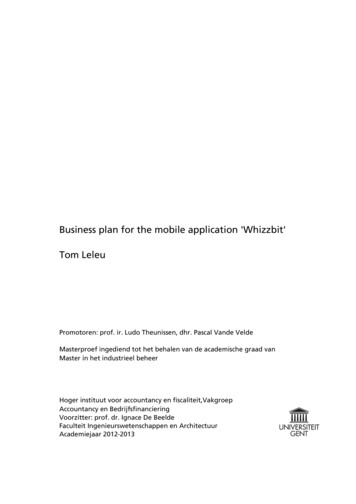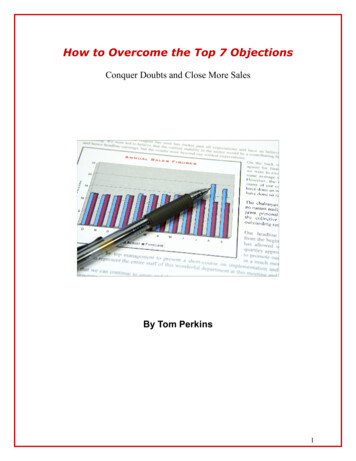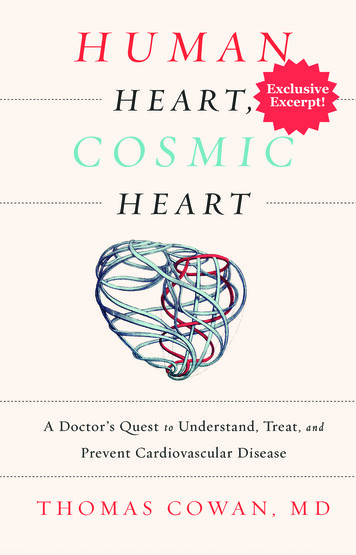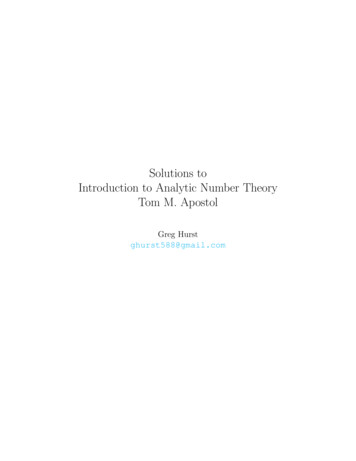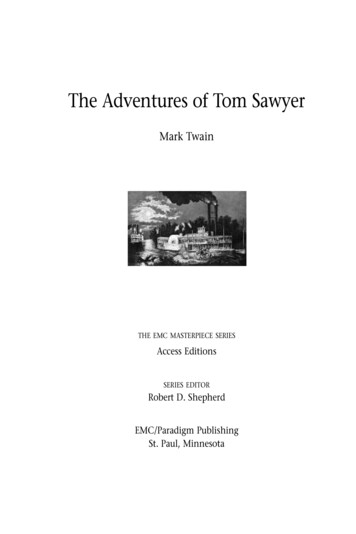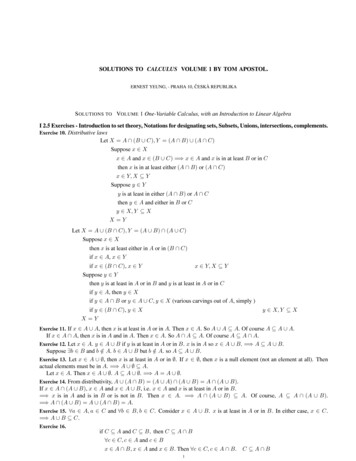
Transcription
SOLUTIONS TO CALCULUS VOLUME 1 BY TOM APOSTOL. REPUBLIKAERNEST YEUNG, - PRAHA 10, CESKAS OLUTIONS TOVOLUME 1 One-Variable Calculus, with an Introduction to Linear AlgebraI 2.5 Exercises - Introduction to set theory, Notations for designating sets, Subsets, Unions, intersections, complements.Exercise 10. Distributive lawsLetX A (B C), Y (A B) (A C)Suppose x Xx A and x (B C) x A and x is in at least Bor inCx is in at least either (A B) or (A C)x Y, X YSuppose y Ytheny is at least in either (A B) or A Cthen y A and either in B or Cy X, Y XX YLetX A (B C), Y (A B) (A C)Suppose x Xx is at least either in A or in (B C)if x A, x Ythenx (B C), x Yx Y, X Yy Ythen y is at least in A or in B and y is at least in A or in Cif y A, then y Xif y A B or y A C, y X (various carvings out of A, simply )ifSupposey (B C), y XX Yy X, Y Xifx A A, then x is at least in A or in A. Then x A. So A A A. Of course A A A.x A A, then x is in A and in A. Then x A. So A A A. Of course A A A.Exercise 12. Let x A. y A B if y is at least in A or in B . x is in A so x A B . A A B .Suppose b B and b / A. b A B but b / A. so A A B .Exercise 13. Let x A , then x is at least in A or in . If x , then x is a null element (not an element at all). Thenactual elements must be in A. A A.Let x A. Then x A . A A . A A .Exercise 14. From distributivity, A (A B) (A A) (A B) A (A B).If x A (A B), x A and x A B , i.e. x A and x is at least in A or in B . x is in A and is in B or is not in B . Then x A. A (A B) A. Of course, A A (A B). A (A B) A (A B) A.Exercise 15. a A, a C and b B, b C . Consider x A B . x is at least in A or in B . In either case, x C . A B C .Exercise 11. IfIfExercise 16.ifC A and C B,thenC A B c C, c A and c Bx A B, x A and x B. Then c C, c A B. C A B1
Exercise 17.(1)ifA BandB Cthen a A, a B. b B, b C.then sincea B, a C, c Csuch thatc / B. a A, a B so a 6 c a. A CA B, B C, A C since, a A, a B, b B, b C. Then since a B, a C . A CA B and B C . B C or B C . A B only. Then A C .Yes, since a A, a B .No, since x 6 A (sets as elements are different from elements)(2) If(3)(4)(5)Exercise 18.A (B C) (A B) (A C)x A (B C)Supposex A and x / B C x / B Cthen x is not in even at least one B or Cthen x (A B) (A C)x (A B) (A C)Supposethenx is at least in (A B) or in (A C) x is at least in A and not in B or in A and not in Cthen consider when one of the cases is true and when both cases are trueExercise 19.Supposex B [ASupposeA Fthen[x B, x /x /[(B A)A FAA FA x / A, A FA Fsince\x x A (B C) A F, x B, x / A,then\x thenx B A1then A F, x B, x /Athenx /\x B x /A FAAA Fthen[A FA FSupposex B A2even at least one x B (B A)and\SupposeAx [(B A)A FA Fx A for A Fthen x is at least in one B A[ x (B A)then at mostthenbut onex is at least in one B Athen forA F, x B and x /AConsider A F A Fthenx B \AA FExercise 20.(1) (ii) is correct.Supposex (A B) CSupposethenx A B, x /Cthenx A and x / B and x /Cx /Bandx / C x /even at leastBorx A (B C)2Cx A (B C)thenx A, x / (B C)thenx A and x / B and x /C x (A B) Cand.
To show that (i) is sometimes wrong,Supposey A (B C)y A and y / B Cy / B Ctheny /Bory Cory /C(where does this lead to?)Consider directly.x (A B) CSupposethenx is at least in A B or in Cthenx is at least in A and /Bx c CSupposec /Aand(2)Ifor in CC A,A (B C) (A B) CI 3.3 Exercises - The eld axioms. The goal seems to be to abstract these so-called real numbers into justx's and y 's thatare purely built upon these axioms.Exercise 1. Thm. I.5.a(b c) ab ac.y ab ac; x a(b c)Want: x yLetac y ab (by Thm.I.2, possibility of subtraction)Note that by Thm. I.3,a(b c) a(b ( c)) ab a( c) (by distributivity axiom)ac x ac ab a( c) a(c ( c)) ab a(0 b) aby or x by Thm. I.2. x y .0 · a a · 0 0.0(a) a(0) (by commutativity axiom)But there exists exactly oneThm. I.6.Givenb R and 0 R, exactly one b s.t. b a 00(a) (b ( b))a ab ab 0 (by Thm.I.5. and Thm. I.2)Thm. I.7.ab acBy Axiom 4, ysince products are uniquely determined, R s.t. ay 1yab yac (ya)b (ya)c 1(b) 1(c) b cThm. I.8. Possibility of Division.a, b, a 6 0, choose y such that ay 1.x yb.GivenLetTherefore, there exists at least onexsuch thatax ayb 1(b) bax b. But by Thm. I.7,there exists only onex(since ifaz b,and sox z ).Thm. I.9. Ifa 6 0, then b/a b(a 1 ).Letbfor ax bay a 1 for ay 1x Want:Nowb(1) b,sox byax b b(ay) a(by) x by (by Thm.a 6 0, then (a ) a.ab 1 for b a 1 . But since b Rab b(a) 1; a b 1 .Thm. I.10. IfNowI.7) 1 1andb 6 0(otherwise31 0,contradiction), then using Thm.I.8 onb,
Thm.I.11. If ab 0, a 0 or b 0.ab 0 a(0) b 0 or ab ba b(0) a 0. (we used Thm.Thm. I.12. Want: x y if x ( a)b and y (ab).I.7, cancellation law for multiplication)ab y 0ab x ab ( a)b b(a ( a)) b(a a) b(0) 00 is unique, so ab y ab x implies x y( by Thm.I.1)x y z , if a bx, c dy, (ad bc) (bd)z .Thm. I.13. Want:(bd)(x y) bdx bdy ad bc (bd)zSo usingb, d 6 0, which is given, and Thm. I.7, then x y z .xy z for bx a, dy c, ac (bd)z .Thm. I.14. Want:(bd)(xy) (bx)(dy) ac (bd)zb, d 6 0, so by Thm. I.7, xy z .Thm.I.15. Want: x yz , if bx a, dy c, (bc)z ad(bc)z b(dy)z d(byz) dad 6 0 so by Thm.I.7, byz a, byz abxb 6 0 so by Thm.I.7, yz x0 z 0. By Thm. I.2, there exists exactly one z , z 0. By Axiom 4, z 0. 0 0. 1Consider 1(z)z(1) 1. Then z 1. But by Axiom 4, there exists distinct 1 such that z(1) 1, so z 1.Suppose there exists x such that 0x 1, but 0x 0 and 0 and 1 are distinct, so zero has no reciprocal .a ( a) 0, 0 0 0. ThenExercise 2. ConsiderExercise 3.Exercise 4.Exercise 5.a ( a) b ( b) (a b) ( a) ( b) 0 (a b) a ( b) a bExercise 6.a ( a) 0, b ( b) 0, soa ( a) b ( b) a ( b) ( a) b (a b) ( a) b 0 0 0 (a b) a b.Exercise 7.(a b) (b c) a ( b) b ( c) a (b ( b)) ( c) a cExercise 8.(ab)x 1(ab) 1 xa(bx) 1a 1 bxb(ax) 1b 1 axa 1 b 1 (abx)x 1(x) (ab) 1Exercise 9. Want:x y z , ifaz b( a)y b³ ax ba ztb t 0by u a u 0³a b x v x 0vb aa ( a) vb by b(v y) 0ifb 6 0, v y 0,by Thm. I.1b t 0,thenbutv x 0,x yz(b t) zb zt zb a z(0) 0a zb 0 a zb bysinceb 6 0, z y so x y z4
b, d 6 0, Letad bcz (bd)z ad bc by previous exercise or Thm. I.8, the possibility of divisionbdax bx ab cdt c (By Thm. I.3, we know that b a b ( a) )t ddbx bdt (bd)(x y) ad bc (bd)zExercise 10. Sinceb, d 6 0,sox y zI 3.5 Exercises - The order axioms.Theorem 1 (I.18). Ifa b and c 0 then ac bcTheorem 2 (I.19). Ifa b and c 0, then ac bcTheorem 3 (I.20). Ifa 6 0, then a2 0Theorem 4 (I.21).1 0Theorem 5 (I.22). Ifa b and c 0, then ac bc.Theorem 6 (I.23). Ifa b and a b.Theorem 7 (I.24). Ifab 0, then both a and b are positive or both are negative.Theorem 8 (I.25). Ifa c and b d, then a b c d.In particular, ifa 0, then a 0.Exercise 1.(1) By Thm. I.19, c 0a( c) b( c) ac bc bc ( ac) ac bc 0. Then ac bc (by de nition of )(2)a b a 0 b 0 a b ( b) b a ( a) (a b) b (a b) ( a)By Thm.I.18(a b) (a b) ( b) (a b) (a b) ( a) b a(3)Ifa 0 or b 0, ab 0, but 0 0Ifa 0, then if b 0, ab 0(b) 0.Ifb 0, ab 0(b) 0.So ifa 0, then b 0.Ifa 0, then if b 0, ab 0(b) 0.Ifb 0, ab 0(b) 0.So ifa 0, then b 0.(4)a c so a b c b b cb d so b c d cBy Transitive LawExercise 2. If2x 0, x 0. 0 1 1 6 0.IfSo,a b d cx 6 0.x 6 0, x2 0,and by Thm. I.212,1 02x 1 0 0 0 x 1 6 0 @x R such that x2 1 0Exercise 3.a 0, b 0, a b 0 0 0 ( By Thm.Exercise 4. Considerax 1.ax 1 0. By Thm.Exercise 5. De neI.25)I.24x, y such that ax 1, by 1., a, x are both positive or a, x are both negativeWe wantx y when b a.xb ax xb 1 0 bx 1 byb 0 so x y5
Exercise 6.Ifa b and b c,thena cIfa b and b c,thena cIfa b and b c,thena ca b and b c, a cthena c (by transitivity of the inequality)Ifa b and b c, then a c. If a c, then by previous proof, a b.Exercise 8. If a b and b c, then a c. If a c, then by previous proof, a b.2222Exercise 8. If a or b is zero, a or b 0. By Thm. I.20, b 0 or a 0, respectively.22Otherwise, if neither are zero, by transitivity, a b 0.Exercise 9. Suppose a x. Then a x 0.If a R so y R, such that a y 0.Consider y 1 R (by closure under addition).Exercise 7. Ifa (y 1) a y 1 0 1 0 Contradiction that a y 1Exercise 10.Ifx 0,Ifx 0, x is a positive real number. done.Leth x x Contradiction.2x.2I 3.12 Exercises - Integers and rational numbers, Geometric interpretation of real numbers as points on a line, Upperbound of a set, maximum element, least upper bound (supremum), The least-upper-bound axiom (completeness axiom), The Archimedean property of the real-number system, Fundamental properties of the suprenum and in mum.We use Thm I.30, the Archimedean property of real numbers, alot.Theorem 9 (I.30). Ifx 0 and if y is an arbitrary real number, there exists a positive integer n such that nx y .We will use the least upper-bound axiom (completeness axiom) alot for continuity and differentiation theorems later.Apostol states it as an axiom; in real analysis, the existence of a sup for nonempty, bounded sets can be shown with analgorithm to zoom into a sup with monotonically increasing and monotonically decreasing sequence of guesses and showingits difference is a Cauchy sequence.Axiom 1 (Least upper-bound axiom). Every nonempty setis, there's a real numberExercise 1.Sof real numbers which is bounded above has a suprenum; thatB s.t. B supS .0 y x. n(y x) h 0, n Z , h arbitraryy x h/n y x h/n xso letExercise 2.x R so n Z such that n x (Thm.z x h/n Done.I.29).Set of negative integers is unbounded below becauseIf m Z , x m, then x is an upper bound on Z .Contradiction of Thm. I.29. m Z such that m x nExercise 3. Use Archimedian property.x 0 so for 1, n Z such that nx 1, x n1 .Exercise 4. x is an arbitrary real number. By Thm. I.29 and well-ordering principle, there exists a smallest n 1 positiveinteger such that x n 1 (consider the set of all m 1 x and so by well-ordering principle, there must be a smallestelement of this speci c set of positive integers).x n for some positive integer n, done.x n, then n 1 couldn't have been the smallest element such that m x. x n.Exercise 5. If x n, done. Otherwise, consider all m x. By well-ordering principle, there exists a smallest element n suchthat n x.If x 1 n, then x n 1, contradicting the fact that n is the smallest element such that x n. Thus x 1 n.Exercise 6. y x 0.n(y x) h, h arbitrary , n Z IfOtherwise, note that ify x h/n z x6
Sinceh was arbitrary, there are in nitely many numbers in between x, y .x ab Q, y / Q.Exercise 7.x y a bybµIfxy a by was an integer, say m, then y ayay b1bIfay was an integer, ay n, y xya mbb¶which is rational. Contradiction.n, but y is irrational. xy is irrational.ay is not an integerExercise 8. Proof by counterexamples. We want that the sum or product of 2 irrational numbers is not always irrational. Ifyy 1 is irrational, otherwise, if y 1 Q, y Q by closure under addition. y 1 y 11Likewise, y 1.yis irrational,Exercise 9.y x 0 n(y x) k, n Z , k arbitrary.y k to be irrational.ChooseThenk/n irrational.kk x x. Let z x , z irrational .nnExercise 10.(1) Supposen 2m1andn 1 2m2 .1. But m1 m2 can only be an integer.2 By the well-ordering principle, if x Zis neither even and odd, consider the set of all x. There must exist a smallest element x0 of this set. But since x0 Z , then there must exist a n x such that n 1 x0 . n is even orodd since it doesn't belong in the above set. So x0 must be odd or even. Contradiction.2m1 1 2m2(2)(3)2(m1 m2 ) 1m1 m2 (2m1 )(2m2 ) 2(2m1 m2 ) even2m1 2m2 2(m1 m2 ) even(2m1 1) (2m2 1) 2(m1 m2 1) sum of two odd numbers is even(n1 1)(n2 1) n1 n2 n1 n 2 1 2(2m1 m2 )2(2m1 m2 ) (n1 n2 ) 1 odd, the product of two odd numbers n1 , n2(4) Ifn2even,22is odd2n is even, since for n 2m, (2m) 4m 2(2m ) is even.a2 2b2 . 2(b2 ) even. a2even, soa even.Ifa even a 2n.a2 4n2Ifb odd , b2odd.b has no factors of 2 b2 6 4n2b is even.pq , If p or q or both are odd, then we're done.lnElse, when p, q are both even, p 2 m, q 2 p, m, p odd.Thus(5) Forp2l m2l n m n q2 ppand at leastm or p oddab can be put into a form such that a or b at least is odd by the previous exercise.a22However, a 2b , so a even, b even, by the previous exercise, part (d) or 4th part. Thusb cannot be rational.Exercise 11.Exercise 12.SincepqThe set of rational numbers satis es the Archimedean property but not the least-upper-bound property. Q R, n pq11 p2q2 since if q1 , q2 0,q1 p2np1 q2 q1 q2q1 q2np1 q2 q1 p2n exists since (p1 q2 ), (q1 p2 ) R.7
The set of rational numbers does not satisfy the least-upper-bound
SOLUTIONS TO CALCULUS VOLUME 1 BY TOM APOSTOL. ERNEST YEUNG, - PRAHA 10, CESK A REPUBLIKA SOLUTIONS TO VOLUME 1 One-Variable Calculus, with an Introduction to Linear Algebra I 2.5 Exercises - Introduction to set theory, Notations for designating sets, Subsets, Unions, intersections, complements. Exercise 10. Distributive laws Let X A\(B [C);Y (A\B)[(A\C)File Size: 1MBPage Count: 281

